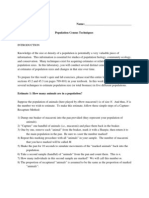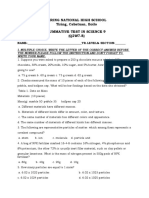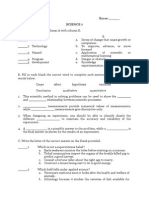Biology Practical Reports For Form 4 Activity 8.6 (Practical Textbook Page 113)
Biology Practical Reports For Form 4 Activity 8.6 (Practical Textbook Page 113)
Uploaded by
ke2Copyright:
Available Formats
Biology Practical Reports For Form 4 Activity 8.6 (Practical Textbook Page 113)
Biology Practical Reports For Form 4 Activity 8.6 (Practical Textbook Page 113)
Uploaded by
ke2Original Description:
Original Title
Copyright
Available Formats
Share this document
Did you find this document useful?
Is this content inappropriate?
Copyright:
Available Formats
Biology Practical Reports For Form 4 Activity 8.6 (Practical Textbook Page 113)
Biology Practical Reports For Form 4 Activity 8.6 (Practical Textbook Page 113)
Uploaded by
ke2Copyright:
Available Formats
BIOLOGY PRACTICAL REPORTS FOR FORM 4
Activity 8.6 (practical textbook page 113)
Objective : To estimate the population size of garden snails using capture, mark, release and
recapture technique.
Apparatus: a paintbrush, a bottle of Indian ink, a pen and a notebook
Technique: count the total number of garden snails captured, marked, released and recaptured
Procedure:
1. A suitable location within the school compound is selected for this activity.
2. As many garden snails as possible is captured from three different places, A, B and C, within
that location.
3. The garden snails that are captured are counted and their shells marked with a small dot of
Indian ink.
4. The marked snails are then released in the same place where they were found.
5. After seven days, as many gardens snails as possible are captured once again from the same
place.
6. The total number of garden snails captured are counted and the number of those which had
been marked are also counted.
7. The results are recorded in a table of results.
8. The population size of garden snails is determined using the following formula:
Population size
ab
= c
no. of animals in 1st sample x no. of animals in 2nd sample
=
no. of marked animals in 2nd sample
9. Safety precaution: The snails must be captured randomly and enough time must be given for
the marked and unmarked snails to mix with the rest of the population.
Results:
Location
A
B
C
Total number of
snails in the
first capture (a)
10
8
10
Second capture
Estimated population
ab
Total number
Total number of
= c
of snails (b)
snails (c)
12
4
30
9
2
36
9
3
30
Discussion:
1.
What is the population size of garden snails in your school compound?
Location A 30
Location B 36
Location C 30
2.
Why are the garden snails released into their habitat after they are marked?
This is to allow them to mingle with the other garden snails again.
3.
The material used to mark the garden snails is miportant. Why is Indian ink used?
Indian ink is used as it is waterproof, non-toxic, does not hinder the snails movement or
make it an easy target for predators.
4.
How can the accuracy of the data is improved?
The accuracy of the data can be improved by taking larger samples. The snails must be
captured randomly and enough time must be given for the marked and unmarked snails to
mix with the rest of the population.
5.
Why are some of the data obtained by capture, mark, release and recapture technique
unreliable? Explain.
This is because the population under study does not take into account factors like birth,
mortality, immigration and emigration.
Conclusion:
The population size of garden snails can be estimated using capture, mark, release and
recapture technique.
You might also like
- Csec Biology labORATORY ManualDocument41 pagesCsec Biology labORATORY ManualKemoy Francis67% (15)
- Class 12 Biology Lab Manual Practical Content 2023-24-1Document14 pagesClass 12 Biology Lab Manual Practical Content 2023-24-1Geetanjali Saraswat86% (7)
- Name: Date: Class: Instruction: For Each of The Questions 1 To 50, Choose The Correct Answer For Each Question From The Four Options A, B, C and DDocument7 pagesName: Date: Class: Instruction: For Each of The Questions 1 To 50, Choose The Correct Answer For Each Question From The Four Options A, B, C and Dke2100% (2)
- IKEA Catalogue 2012Document189 pagesIKEA Catalogue 2012nguyễn thăng vănNo ratings yet
- Catch Me If You Can Frog Beans Population CountingDocument4 pagesCatch Me If You Can Frog Beans Population CountingJohn OsborneNo ratings yet
- Mark and Recapture Theory and With Pill BugsDocument3 pagesMark and Recapture Theory and With Pill BugsJohn OsborneNo ratings yet
- 'Catch Me If You Can' Frog Beans Lincoln IndexDocument4 pages'Catch Me If You Can' Frog Beans Lincoln IndexJohn OsborneNo ratings yet
- Biology Practicals PDFDocument23 pagesBiology Practicals PDFLalitha SrinuNo ratings yet
- XII Practical NotesDocument6 pagesXII Practical NotesjayasuryaneetNo ratings yet
- Population EstimationDocument5 pagesPopulation EstimationummerashiddiariesNo ratings yet
- Activity 3 Endangered But Not ExtinctDocument1 pageActivity 3 Endangered But Not ExtinctNouiea Bernardelle Acabal75% (4)
- Experiment 20Document12 pagesExperiment 20Pang Wei NaNo ratings yet
- Prac - Capture-Recapture With MealwormsDocument8 pagesPrac - Capture-Recapture With MealwormsqwertNo ratings yet
- Pag 7 Style Qs From Spec A and B 1Document9 pagesPag 7 Style Qs From Spec A and B 118gmillsNo ratings yet
- Standard 10Document12 pagesStandard 10api-312341089No ratings yet
- Biology Lab Study MaterialDocument7 pagesBiology Lab Study MaterialNishanth PNo ratings yet
- PDF DocumentDocument53 pagesPDF Documentbrie100% (3)
- Mark-Recapture Method LessonDocument5 pagesMark-Recapture Method LessonCristine BolesNo ratings yet
- Ecology GraphsDocument3 pagesEcology GraphsctaylorsphsNo ratings yet
- Experiment 20Document8 pagesExperiment 20Tay Joo FangNo ratings yet
- Fourth Quarterly Test in Mathematics 6Document5 pagesFourth Quarterly Test in Mathematics 6JONABELLE BALDERASNo ratings yet
- Class 5 QuestionsDocument4 pagesClass 5 Questionskarnritik789No ratings yet
- Census LabDocument13 pagesCensus Labnehru09No ratings yet
- Arithmetic SequenceDocument3 pagesArithmetic SequencehafsaabdinasirmNo ratings yet
- DLP Math 6 Q4Document6 pagesDLP Math 6 Q4Dynah Fe Laborte TamayoNo ratings yet
- Research Plan (To Accompany Form 1A)Document6 pagesResearch Plan (To Accompany Form 1A)api-484215877No ratings yet
- Itl Public School Sector - 9, Dwarka: SESSION 2014 - 2015Document3 pagesItl Public School Sector - 9, Dwarka: SESSION 2014 - 2015ik62299No ratings yet
- Ecology WorksheetDocument12 pagesEcology WorksheetManongdo Allan0% (1)
- Tiring National High School Tiring, Cabatuan, Iloilo Summative Test in Science 9 (Q2W7-8)Document3 pagesTiring National High School Tiring, Cabatuan, Iloilo Summative Test in Science 9 (Q2W7-8)bellasal123592No ratings yet
- Class 6 ScienceDocument8 pagesClass 6 Sciencemuzzammil.memonsNo ratings yet
- KCSCDocument21 pagesKCSCfatema19447No ratings yet
- SamplingDocument25 pagesSamplingcarlotarubioperez123No ratings yet
- Myp1 HHW MAY 23Document9 pagesMyp1 HHW MAY 23bhumi.c8216No ratings yet
- Biology 10 Exam AnswersDocument6 pagesBiology 10 Exam AnswersNicolás SerranoNo ratings yet
- Estimating Population Sizes - Maryam FDocument1 pageEstimating Population Sizes - Maryam Fapi-464088459No ratings yet
- Midterm Review PHYS (Online) BlankDocument7 pagesMidterm Review PHYS (Online) Blankpatelsagar200511No ratings yet
- XII Biology Practicals 2022-23Document24 pagesXII Biology Practicals 2022-23kuntalsaikia82No ratings yet
- Carapichaima East Secondary School End of Term Exam-Integrated Science Term I 2014 - Form 1 Time:1 HoursDocument6 pagesCarapichaima East Secondary School End of Term Exam-Integrated Science Term I 2014 - Form 1 Time:1 HoursRianna SatramNo ratings yet
- Physics OnemarkDocument6 pagesPhysics Onemarkakilanrider17No ratings yet
- Laboratory Exercise 2Document3 pagesLaboratory Exercise 2Wallace Dave Hajjy P LimNo ratings yet
- 1st Quarter ExamDocument3 pages1st Quarter ExamJudith Molina100% (2)
- Sampling Techniques Notes For Grdae 8 Bio IGCSE / MSPDocument6 pagesSampling Techniques Notes For Grdae 8 Bio IGCSE / MSPshouryaNo ratings yet
- Question Paper Science 2022 7 8Document19 pagesQuestion Paper Science 2022 7 8Ainna AliNo ratings yet
- Atomic Energy Education Society: Anushaktinagar, MumbaiDocument4 pagesAtomic Energy Education Society: Anushaktinagar, Mumbaismruti sangitaNo ratings yet
- Comparing Biodiversity SpidersDocument4 pagesComparing Biodiversity Spidersapi-235658421No ratings yet
- Carapichaima East Secondary School End of Term Exam-Integrated Science Term I 2014 - Form 1 Time:1 HoursDocument6 pagesCarapichaima East Secondary School End of Term Exam-Integrated Science Term I 2014 - Form 1 Time:1 HoursrutasojaneNo ratings yet
- P3 Science Midtest (CHP 1, 2, 5, 6 and 7) Semester 1Document5 pagesP3 Science Midtest (CHP 1, 2, 5, 6 and 7) Semester 1Wilson SunantoNo ratings yet
- Biology Lab Manual - Xii - 2023 - 24Document39 pagesBiology Lab Manual - Xii - 2023 - 24Navneet ChoudharyNo ratings yet
- Sample Lesson Plan - EcologyDocument7 pagesSample Lesson Plan - EcologyKayon DavisNo ratings yet
- Name: Score: - Science 7Document4 pagesName: Score: - Science 7Jjr BacongcoNo ratings yet
- Tutorial 1Document3 pagesTutorial 1berapiNo ratings yet
- Biology Practicals 2023-2024Document20 pagesBiology Practicals 2023-2024pradhidhan1902No ratings yet
- Species Area Curve LabDocument6 pagesSpecies Area Curve LabNoah Archibald100% (1)
- Human Impact and Population Dynamics LabDocument12 pagesHuman Impact and Population Dynamics Labapi-31893794250% (2)
- Preparatory Exam Nov-Dec 2023Document15 pagesPreparatory Exam Nov-Dec 2023Dr. M. Prince100% (1)
- Sol Review Scientific InvestigationDocument34 pagesSol Review Scientific Investigationapi-254115397No ratings yet
- Black HoleDocument2 pagesBlack HoleLouis Fetilo Fabunan0% (1)
- 2nd Quarter SienceDocument8 pages2nd Quarter SienceJohn Bailor FajardoNo ratings yet
- Holiday HW Grade 7Document2 pagesHoliday HW Grade 7api-2889652230% (1)
- Ibo2004 Theory Examination 1Document59 pagesIbo2004 Theory Examination 1medja2233No ratings yet
- CH 04 ADocument5 pagesCH 04 AMoath AlobaidyNo ratings yet
- O Level Biology Practice Questions And Answers: Ecology And Our Impact On The EcosystemFrom EverandO Level Biology Practice Questions And Answers: Ecology And Our Impact On The EcosystemNo ratings yet
- Add-Maths ProjectDocument14 pagesAdd-Maths Projectke2No ratings yet
- Add-Maths ProjectDocument14 pagesAdd-Maths Projectke2No ratings yet
- Past Year QuestionsDocument4 pagesPast Year Questionske2No ratings yet
- Novel Catch Us If You CanDocument25 pagesNovel Catch Us If You Canke2No ratings yet
- A B C D Biology: Nama Pelajar: Kelas: MarkahDocument4 pagesA B C D Biology: Nama Pelajar: Kelas: Markahke2No ratings yet
- C D A B C D Biology Assessment TestDocument4 pagesC D A B C D Biology Assessment Testke2No ratings yet
- Name: Date: Class: Instruction: For Each of The Questions 1 To 30, Choose The Correct Answer For Each Question From The Four Options A, B, C and DDocument4 pagesName: Date: Class: Instruction: For Each of The Questions 1 To 30, Choose The Correct Answer For Each Question From The Four Options A, B, C and Dke2No ratings yet
- Biology Practical Reports For Form 4 Activity 8.8 (Practical Textbook Page 115)Document2 pagesBiology Practical Reports For Form 4 Activity 8.8 (Practical Textbook Page 115)ke2No ratings yet
- D Biology: Nama Pelajar: Kelas: MarkahDocument6 pagesD Biology: Nama Pelajar: Kelas: Markahke2No ratings yet
- Biology Practical Reports For Form 4 Experiment 8.11 (Practical Textbook Page 119)Document2 pagesBiology Practical Reports For Form 4 Experiment 8.11 (Practical Textbook Page 119)ke2No ratings yet
- Biology Practical Reports For Form 4 Activity 8.5 (Practical Textbook Page 111)Document2 pagesBiology Practical Reports For Form 4 Activity 8.5 (Practical Textbook Page 111)ke2No ratings yet
- Biology Practical Reports For Form 4 Experiment 9.2 (Practical Textbook Page 128)Document2 pagesBiology Practical Reports For Form 4 Experiment 9.2 (Practical Textbook Page 128)ke20% (1)
- Biology: Nama Pelajar: Kelas: MarkahDocument4 pagesBiology: Nama Pelajar: Kelas: Markahke2No ratings yet
- Biology Practical Reports For Form 4 Experiment 8.3 (Practical Textbook Page 108)Document2 pagesBiology Practical Reports For Form 4 Experiment 8.3 (Practical Textbook Page 108)ke2100% (1)
- Biology F4Chapter 6 (Ver1)Document4 pagesBiology F4Chapter 6 (Ver1)ke2No ratings yet
- D Biology: Nama Pelajar: Kelas: MarkahDocument5 pagesD Biology: Nama Pelajar: Kelas: Markahke2No ratings yet
- Name: Date: Class: Instruction: For Each of The Questions 1 To 30, Choose The Correct Answer For Each Question From The Four Options A, B, C and DDocument5 pagesName: Date: Class: Instruction: For Each of The Questions 1 To 30, Choose The Correct Answer For Each Question From The Four Options A, B, C and Dke2No ratings yet
- Name: Date: Class: Instruction: For Each of The Questions 1 To 30, Choose The Correct Answer For Each Question From The Four Options A, B, C and DDocument4 pagesName: Date: Class: Instruction: For Each of The Questions 1 To 30, Choose The Correct Answer For Each Question From The Four Options A, B, C and Dke2No ratings yet
- Name: Date: Class: Instruction: For Each of The Questions 1 To 30, Choose The Correct Answer For Each Question From The Four Options A, B, C and DDocument4 pagesName: Date: Class: Instruction: For Each of The Questions 1 To 30, Choose The Correct Answer For Each Question From The Four Options A, B, C and Dke2100% (1)
- Biology Practical Reports For Form 4 Experiment 3.6 (Practical Textbook Page 30)Document2 pagesBiology Practical Reports For Form 4 Experiment 3.6 (Practical Textbook Page 30)ke250% (2)
- Biology Practical Reports For Form 4 Experiment 3.1 (Practical Textbook Page 20)Document2 pagesBiology Practical Reports For Form 4 Experiment 3.1 (Practical Textbook Page 20)ke267% (3)
- Backyard BiologistDocument2 pagesBackyard Biologistapi-234287636No ratings yet
- Data Sheet - Cyber Investigator Nse21Document5 pagesData Sheet - Cyber Investigator Nse21James WangNo ratings yet
- A SWOT Analysis To Improve The Marketing of Young Coconut ChipsDocument10 pagesA SWOT Analysis To Improve The Marketing of Young Coconut ChipsPRO TradesmanNo ratings yet
- Member Data Record: Serviño, Ethel Rose CarmeloDocument1 pageMember Data Record: Serviño, Ethel Rose Carmeloethel rose servinoNo ratings yet
- Naemd BrochureDocument36 pagesNaemd BrochureGarima MittalNo ratings yet
- Mechanics: Classical Versus QuantumDocument11 pagesMechanics: Classical Versus QuantumJaneeshVargheseNo ratings yet
- Ielts Speaking Part 2 Questions and Answers PDF 40 d33486f7b9Document3 pagesIelts Speaking Part 2 Questions and Answers PDF 40 d33486f7b9Asad MiltonNo ratings yet
- Test 2Document23 pagesTest 2Hiếu EuroNo ratings yet
- ApacheHVAC User Guide - Virtual Environment - 6.1Document188 pagesApacheHVAC User Guide - Virtual Environment - 6.1leungNo ratings yet
- Weighted Moving AverageDocument8 pagesWeighted Moving AveragePam G.No ratings yet
- Parametric Design of Sailing Hull Shapes: Antonio MancusoDocument13 pagesParametric Design of Sailing Hull Shapes: Antonio MancusolavrikNo ratings yet
- Compulsory Ethiopian Standard: CES XXDocument19 pagesCompulsory Ethiopian Standard: CES XXAbdella Mohammed AdemNo ratings yet
- Simulation For Façade Options and Impact On Hvac System DesignDocument8 pagesSimulation For Façade Options and Impact On Hvac System DesigncarlosloucaoNo ratings yet
- Simple Past Tense - Regular VerbsDocument11 pagesSimple Past Tense - Regular VerbsFabi Usma PalacioNo ratings yet
- LaajVanti EbookDocument179 pagesLaajVanti EbookSridhar YvNo ratings yet
- On Basic Electrical - 1Document18 pagesOn Basic Electrical - 1Sakshi RanaNo ratings yet
- Machine Profiles: D10R Track-Type TractorsDocument5 pagesMachine Profiles: D10R Track-Type TractorsJavier Pagan TorresNo ratings yet
- mmf2 Develop HelpDocument187 pagesmmf2 Develop HelpStelios LafazanisNo ratings yet
- Danica LDR PanelDocument2 pagesDanica LDR PaneldanielbustNo ratings yet
- PACX User GuideDocument20 pagesPACX User GuideKewyn FerreiraNo ratings yet
- 4 EAGLE 2024 Prents Permit Activity RosterDocument3 pages4 EAGLE 2024 Prents Permit Activity RosterRichard SluderNo ratings yet
- Take Me With YouDocument2 pagesTake Me With YouVitty OliveiraNo ratings yet
- Phrasal Verbs - GrammarDocument24 pagesPhrasal Verbs - GrammarRosalba Bryan100% (2)
- Have Mercy On Us AutosavedDocument11 pagesHave Mercy On Us AutosavedMyrel Cedron TucioNo ratings yet
- AIS - Written ReportDocument10 pagesAIS - Written ReportMohammad Nowaiser MaruhomNo ratings yet
- Pass Leader DumpsDocument30 pagesPass Leader DumpsHyder BasetNo ratings yet
- ICSE - Geog - India Location, Extent, Political - 1Document13 pagesICSE - Geog - India Location, Extent, Political - 1Tara bhai JoginderNo ratings yet
- 1st Quarter Performance Task FREE FALLDocument28 pages1st Quarter Performance Task FREE FALLNimrod KoNo ratings yet
- Hooks DynaplexDocument8 pagesHooks DynaplexjohangomezruizNo ratings yet














































































































